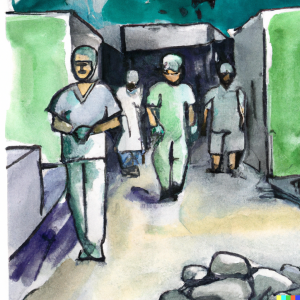
Leading the Charge in the Anti-Bullying Crusade
Updated December 4, 2024
October’s Bullying Prevention Month highlights an urgent public health concern affecting diverse age brackets. However, the youth remain especially at risk. Journey with us through this pivotal discussion, unveiling how public health champions craft strategic measures to mitigate bullying, ensuring nurturing spaces for our emerging generation. This endeavor transcends mere data; it’s a commitment to fortifying our youth’s emotional resilience and dreams.
Let me get personal for a second. As a three-time failed school board candidate, I think it’s critical to incorporate great mental health services and support policies into our schools. As I gear up for another run (maybe), the wellbeing of children is certainly on my mind.
Strategies to address bullying
- Fueling the Flame of Awareness:
Bullying’s omnipresence requires our unwavering focus. As beacon bearers, public health professionals galvanize communities, parents, educators, and pupils. By revealing bullying’s expanse and implications, they anchor communities in an informed defense mechanism that recognizes and counteracts bullying in its initial stages. But bullying’s influence isn’t limited to playground boundaries; it permeates online arenas, workplaces, and communities, imprinting indelible emotional traumas. Only by lighting the awareness beacon can we tackle this issue comprehensively. - Backing What Works – Evidence-Based Strategies:
In the anti-bullying fight, our defensive arsenal is as strong as the strategies we deploy. Professionals champion time-tested bullying prevention measures that mold both schools and communities. These strategies infuse indispensable life attributes like empathy, constructive conflict management, and assertiveness bolstered by unwavering anti-bullying directives. Proven programs have consistently sculpted young minds, equipping them with the emotional acumen to tread confidently in our complex global tapestry. Beyond deterring bullying, they craft the changemakers of tomorrow. - Empowering the Educator Brigade:
Educators wear multiple hats, one being the guardian of student well-being. It’s vital to provide them with comprehensive training that spans the gamut—from identifying verbal derogatory remarks to confronting the menace of cyberbullying. Their role remains instrumental in chiseling out havens of safety and security for students. In our expanding digital age, it becomes even more imperative for public health mavens to ensure that educators can discern and navigate the intricacies of online engagements, emerging as the new battleground for bullying. - Cultivating Synergies:
Eradicating bullying necessitates a harmonized effort. Successful endeavors stem from the collaborative spirit binding public health entities, academic infrastructures, parents, and community assemblies. In our digitized world, social media emerges as a conduit to collaborate, disseminate resources, and spark collective metamorphosis. By harnessing the collaborative potential of our interconnected milieu, we can repurpose social media into a reservoir of positivity, amplifying the reach and impact of our shared mission. - Weaving Safety Nets – Robust Support Systems:
Bullying survivors need tangible, structured support. Public health stalwarts pave avenues to therapeutic anchors, offering victims the specialized aid they need. Ensuring smooth, uninterrupted access to mental well-being resources within educational and communal ecosystems is non-negotiable. Addressing the aftermath of bullying isn’t merely about lending a sympathetic ear but providing expert, therapeutic scaffolding that facilitates healing and rejuvenation. - Galvanizing Peer-Led Movements:
A culture embedded in kindness, empathy, and inclusivity germinates from within the community. Health champions fervently support initiatives steered by peers that instill an ethos of mutual respect. As students resonate with their tales, they collectively weave a transformative narrative, echoing change within their environments. Such grassroots, peer-driven campaigns empower youngsters to pioneer the creation of compassionate atmospheres, reshaping the very essence of educational and social landscapes.
Conclusion:
Navigating the bullying quagmire necessitates a cohesive, informed alliance, with public health visionaries spearheading initiatives. Their endeavors—spanning from catalyzing awareness, endorsing evidence-backed strategies, buttressing educators, fostering collaborations, anchoring robust support systems, to driving peer-centric movements—are laying the foundation for a safer, luminous tomorrow for our youth. Collectively, we’re chiseling a world rich in understanding and inclusivity.
Resources:
Update: December 4, 2024.
We got a really nice note about this blog,
Hi,
I’m Nicole, and I wear the hats of Parenting Coach and Child Safety Expert (plus about ten others, because parenting, am I right?).
While I was deep-diving into the internet (and avoiding my own children for a hot minute), I found this goldmine of a guide: The Ultimate Parent Guide for Child Internet Safety
It isn’t just a bunch of stats that make parents want to move to a cabin in the woods with no Wi-Fi. It’s packed with actionable tips on protecting our kids from the wild, wild web. It talks about everything from cyberbullying to those sneaky predators, and even how to handle the inevitable moment when your kid stumbles upon something very… educational that you did not want them to see.
It would be amazing if you could add this guide to your page here:.. If I found your page, lots of other frantic parents will too, and we could really use all the help we can get!
Thanks a ton!
Stay sane and keep those little ones safe,
Thanks, Nicole! We are happy to share and disseminate information that people find helpful! So, for everyone else, don’t hesitate to send things our way!
Join the Community – Get Your Weekly Public Health Update!
Be a health leader! Subscribe for free and share this blog to shape the future of public health together. If you liked this blog, please share it! Your referrals help This Week in Public Health reach new readers.



